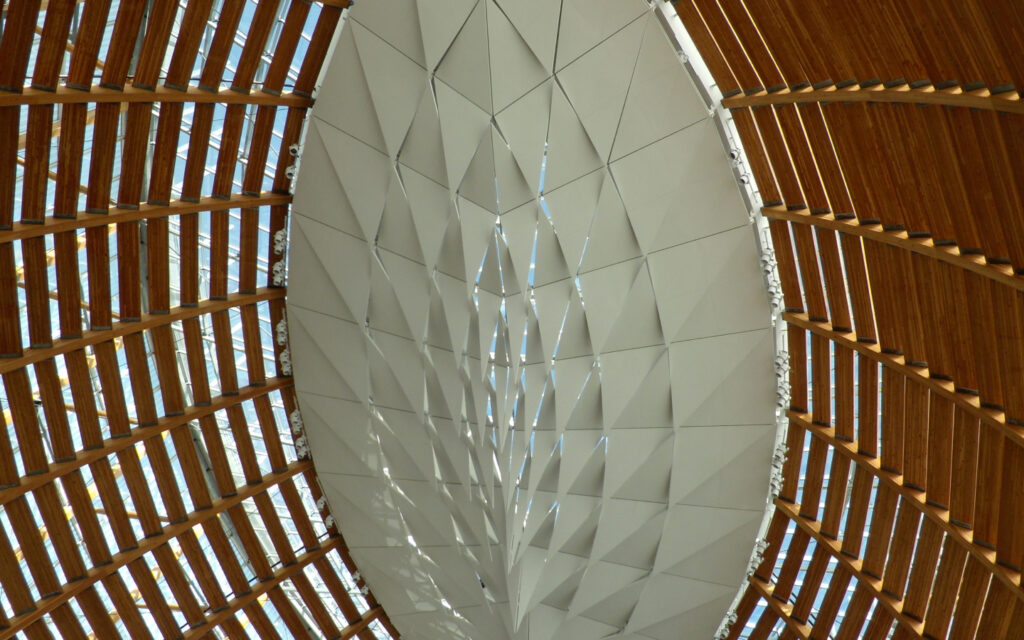Nancy Alexander
Independent Scholar nancyalexander79@gmail.com
Some scholars of geography, architecture and design, religion and spirituality, sociology and anthropology, have studied sacred space and religious and spiritual experience, and some have specifically considered women’s experience, but few have studied the intersection: women’s sacred space. Betsky (1995), for example, observes that, like most public and private space and resources, Western sacred space – space set aside for worship and connection with the divine – has historically been controlled by men. Sacred spaces have tended to have a male form and geometry; sacred rituals within them are most often performed by men; men generally determine and limit women’s access and participation. Here is where the discussion often stops, however, yet it is well worth observing that the task of assertively “making the spirit an earthly home” has thus been quite different for women than for men.
The binary construct of gender assigned certain characteristics, domains and activities to men and their opposites to women, for example heaven-earth, intellect-feeling, public-private, builtnatural, sacred-profane; in the binary, men as active builders and makers of traditional worship space would in theory relegate women to the role of passive occupants. As Weisman says, “Architecture … is a record of deeds done by those who had the power to build” (1992). Yet women also have active religious and spiritual lives, and they have found abundant ways and places in which to encounter the divine as creators and shapers of an alternative and richly varied architecture of the sacred. This paper proposes a theory of women’s sacred space which suggests that women employ several recognizable strategies to “make a home for the spirit,” and that women’s sacred spaces share a number of characteristics, variables, and forms which differentiate them from traditional worship space. A specific consideration of women – i.e., viewing sacred place and space through a gender lens – also opens up the discussion of sacred place from the physical, grounded, and bounded to a more conceptual and abstract architecture of space, to the extent that in some cases the sacred space not only expresses the ineffable, it is itself ineffable. Welcoming the “feminine,” then, can release the equation of “sacred space” with “religious architecture” into a more vast realm of environments for experiencing the divine, including environments anchored directly in the heart of the profane, or “the Ultimate in the midst of life” (King 1993).
To create loci for spiritual expression, worship, and connection, women have long established their own sacred spaces by reactivating or re-appropriating traditional sacred or profane space, thereby creating heterotopic, contested space (Foucault 1986); by re-experiencing or renaming the ordinary as sacred; and by creating exclusively female space – each at scales from the individual to the global and universal. A few examples of women’s sacralization of space include las madres de la plaza de mayo, medieval convent culture, roadside memorials, the monuments of Maya Lin and religious and secular buildings designed by women architects and for women clients.
Women’s sacred spaces also share a few characteristics which distinguish them from traditional worship space. First, they tend to be more subjective, sacred to the person who names them so but not necessarily to anyone else, and so also potentially contested. (By contrast, although not everyone entering, say, a mosque will experience it as a sacred space, most everyone will likely agree that it is one.)
Second, women’s sacred spaces can vary in scale much more than traditional religious architecture, from the invisible to the universal, and they may be solid and physical – like a home altar – or ephemeral, like a treasured relationship.
Third, unlike the borders around traditional worship space, the boundaries around women’s sacred spaces vary in their distinctness or blurriness: while a garden tends to have a clear edge, the space of a woman’s imagination, which she might consider to be sacred, can spill into every moment and place.
Fourth, the borders of women’s sacred space vary in their permeability. Although there is no space in human experience that is absolutely invulnerable, the borders around the spaces of women – their bodies, their work spaces, or their inner space – all are more subject to interruption, intrusion, or violation than those of men.
Finally, women’s conceptions of sacred space tend to extend to sacred time as well, with the two sometimes conflated as in the expression, “I need some space,” a buffer zone of both space and time around the speaker.
A feminist analysis of gendered sacred space – drawing on Kristeva and Clement (1998), Irigaray (2004), Betsky (1995), and Agrest (2000), among others – finds women’s agency historically (and still today) countered by male authority. For example, convents, while offering a haven for spiritual expression and creativity, nonetheless were established to serve men’s economic and social purposes. Thus there is an inherent tension in the “architecture” of women’s sacred space between the functions of retreat and resistance. Yet this tension, combined with the constraints on women’s occupancy of traditional sacred space which channeled their attention inward to spiritual matters and private praxis, have thus over time actually fostered women’s leadership and participation in spiritual movements more than in religious organizations. As pioneers of spiritual space, women have tended to ignore the dichotomy of “sacred” and “profane,” and have more easily experienced and taught an unbounded conception of the divine. In the United States, the rise in spirituality as a phenomenon distinct from religion coincided with and was inspired by the beginning of the women’s rights movement; women’s exclusion from traditional sacred space, combined with their growing autonomy, caused the sacred spaces which they appropriated to become a womb for their spiritual development and ultimately a significant outlet for public leadership.
As in many facets of Western society, the women’s movement and the rising recognition of women’s agency and voices have infiltrated and inspired mainstream culture in the post-modern era, and caused designers and users of traditional worship space to become more receptive to “feminine” conceptions of sacred space. This feminization of the public psyche has in turn made an “earthly home for the spirit” within and far beyond the walls of religious spaces, reaching to the Berlin Wall, the gates of Buckingham Palace, and the site of the World Trade Center, sites of protest, celebration, and memorial.
I offer this theory as a call to further speculation, question, discussion, challenge, and engagement. Perhaps it will inspire future researchers to analyze religious and spiritual experience more often through a gender lens. It invites potential research into an array of women’s sacred spaces with which to test the validity of the theory and its admittedly vulnerable assumption of a universality of women’s experience. And finally, it makes room for a vast reconception of what sorts of spaces serve to inspire and house sacred experience.
References
Agrest, Diana. “Architecture from Without: Body, Logic and Sex.” Gender Space Architecture: An Interdisciplinary Introduction. Rendell, Jane, Barbara Penner, and Iain Borden, eds. London: Routledge, 2000. 358-70.
Betsky, Aaron. Building Sex: Men, Women, Architecture, and the Construction of Sexuality. New York: William Morrow, 1995.
Clément, Catherine and Julia Kristeva. The Feminine and the Sacred. Trans. Jane Marie Todd. New York: Columbia UP, 1998.
Foucault, Michel. Power/Knowledge: Selected Interviews and Other Writings, 1972-1977. C. Gordon, Ed. New York: Pantheon, 1980.
Irigaray, Luce. Key Writings. London: Continuum, 2004.
King, Ursula. Women and Spirituality. University Park, PA: Pennsylvania State UP, 1993.
Weisman, Leslie Kanes. Discrimination by Design: A Feminist Critique of the Man-Made Environment. Urbana: U of Illinois P, 1992.




